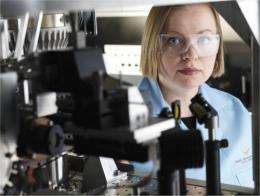Gases drawn into particles stay there

(Phys.org) -- Contrary to expectations, formation and growth of complex organic particles generated during oxidation of volatile organic molecules by ozone and nitrate follows a non-equilibrium path, according to a recent study in the Proceedings of the National Academy of Sciences.
The formation kinetic data show that the organic nitrates do not dissolve in the organic particles, but rather condense on quasi-solid particles' surfaces, where they are trapped, proving unequivocally that these particles are not in a liquid state. The study was conducted by University of California, Irvine chemist Prof. Barbara Finlayson-Pitts in collaboration with Dr. Alla Zelenyuk at Pacific Northwest National Laboratory.
These findings represent an important step in the development of a fundamental mechanistic understanding of the formation and properties of complex organic particles, putting into question prevailing assumptions used in current aerosol models. Reformulation of aerosol models would affect the predicted formation and evolution of organic aerosols, their role in heterogeneous chemistry, their projected impacts on air quality, visibility, and climate, and hence the development of reliable control strategies.
SPLAT, a one-of-a-kind single particle mass spectrometer that resides in EMSL, was used to characterize in great detail the properties of millions of particles that were formed in the 26-foot-long "aerosol flow tube" at AirUCI.
"What made these findings possible is the ability to characterize multitude of individual particles' properties with high precision," said Zelenyuk. "Incorporating what we found about these particles into models will provide fundamental understanding of formation and transformations of complex organic particles."
This research project represents the initial step towards developing a fundamental, mechanistic theory of organic particle formation and evolution. Future research will proceed to test how general the findings are to other organic particles formed under different conditions from different precursors. In parallel, a fundamental modeling framework that takes the experimental findings into account will be developed.
More information: V Perraud, et al. 2012. "Nonequilibrium atmospheric secondary organic aerosol formation and growth." Proceedings of the National Academy of Science. 109:2836-2841. DOI: 10.1073/pnas.1119909109
Journal information: Proceedings of the National Academy of Sciences
Provided by Pacific Northwest National Laboratory



















